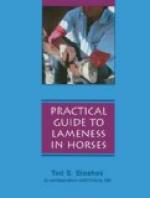In establishing a diagnosis in such cases, the student or practitioner seldom has recourse to laboratory assistance, and his work is done by means of physical examination; therefore, a thorough knowledge and a clear conception of the physiology of locomotion are essential. Memorizing nosological facts without an understanding of underlying principles is of no more practical benefit for qualification as a diagnostician in cases of lameness, than is the employment of similar methods in the study of theory and practice. A knowledge of the dosage of drugs does not in itself qualify one as being competent to administer such therapeutic agents to a proper effect. How much is a practitioner benefited by the knowledge that a high temperature is usually present in septic intoxication, if he is not possessed of a scientific understanding of anatomy, physiology, bacteriology and pathology, as well as the principles of clinical diagnosis?
In order to determine the reasons for certain symptoms manifested by the subject, an analysis of these symptoms is the proper method of procedure, insofar as this is possible. If one may reason that an animal assumes a certain position while at rest to allow relaxation of an inflamed tendon or ligament, such a fact enables the diagnostician to recall that this is indicative of some specific ailment. In acute tendinitis, the subject while at rest, maintains the affected member in volar flexion because this position permits relaxation of the inhibitory apparatus, including the inflamed tendon. Likewise, the various abnormal positions assumed,—adduction, abduction, undue flexion or pointing—have their own significance and are taken into account by the trained diagnostician in the course of an examination.
In the examination of lame subjects, where the cause is not obvious, a systematic method of diagnosis is pursued even by the most expert practitioners. In all obscure cases of lameness a methodical and thoroughly practical examination of the animal according to an established procedure is necessary to determine the nature and source of the affliction.
Anamnesis.
The first thing to be given consideration in diagnosis is the fact that related history of the case is not always dependable, because of lack of accurate observation or wilful deceit on the part of the owner or attendant. The successful veterinarian soon acquires the faculty of obtaining information in a manner best adapted to his client,—either by direct interrogation or by subtle means of suggestion, and in this way he draws out evaded facts essential to his diagnosis. In time he learns to make allowance for misstatements made to shield the owner or driver and to hide the facts of apparent neglect or abuse that the subject may have experienced. A suppurating cartilaginous quittor, complicated by the presence of a large amount of hyperplastic tissue, cannot be successfully represented to be an acute and recently developed affection, where a trained practitioner is left to judge the validity of the statement.




